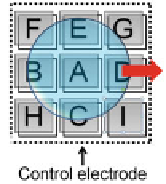Hardware Reference
In-Depth Information
Fig. 6.13
The “large”
droplet contacts both
diagonal and non-diagonal
adjacent electrodes
So, if we set the length and width of the electrode as 1 unit length, the gap between
electrodes is 0.02 unit length. Assume that the diameter of the droplet is D unit
length, then according to Equation
6.6
, the relationship between D and the force
applied to the droplet is shown in Fig.
6.12
b. We can find that, the force applied to
the droplet does not increase any further when the diameter of the droplet increases
to 1.46 unit length.
Note that when the size of the droplet increases, it may contact diagonally
adjacent electrodes as well as non-diagonally adjacent electrodes (Fig.
6.12
c). In
this case, if a non-diagonal electrode is actuated, there will be a force (F
D
) applied to
the droplet in the diagonal direction. For the same droplet, the relationship between
the diameter of the droplet and the value of
k
F
D
k
k
can be found in Fig.
6.12
d. We
F
k
can find that the value
k
F
D
k
kF k
increases as the diameter of the droplet increases. When
the diameter of the droplet increases to 1.78 unit length, we have
k
F
D
kDk
F
k
.
This means that, for a “large” droplet, the influence of its diagonal electrodes can
no longer be ignored. In this case, when moving a droplet from one electrode to its
non-diagonally adjacent electrode, all the diagonal electrodes of the droplet must
be applied “Low” voltage. Otherwise these diagonal electrodes of the droplet will
influence the movement of the droplet.
An example is shown in Fig.
6.13
. In this case, the movement of the droplet is
influenced by the nine electrodes in contact with it. In order to move the droplet
in the direction of the arrow, pin D must be “High”, while the low voltage must
be applied to all other pins. From this example, we can find that biochips that are
required to manipulate a large droplet must satisfy the Constraint
1
and Constraint
2
in Lemma
6.1
in Sect.
6.1
with the difference that the CEG includes all the nine
electrodes in contact with the droplet.
6.6
Scheduling of Fluid-Handling Operations
For the proposed general-purpose biochip, fluid-handling operations must be sched-
uled after the pins are assigned to electrodes. This is in contrast to bioassay-specific
design where the scheduling precedes pin-assignment. In our work the initial
schedule is derived without considering any pin constraints, and then the schedule
is adjusted according to the pin-assignment configuration.

